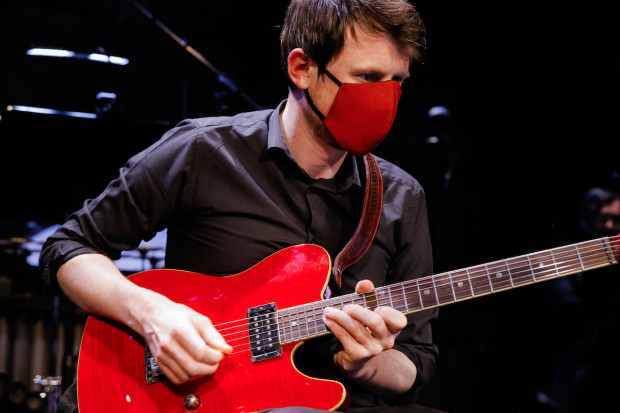
Lina Andonovska performing Brigitta Muntendorf’s ‘Public Privacy #1: Flute Cover’ at Music Current last week (Photo: Mihai Cucu)
Picturing Flutes
The final night (11 November) of this year’s Music Current consisted of two short, intimate concerts by flautists Lina Andonovska and Richard Craig.
Andonovska’s recital opened with what was by far the most expansive work of the night, Nicole Lizée’s Tarantino Études (2015). This 22-minute piece includes a prominent video projection of Quentin Tarantino films, especially the action sequences of Kill Bill – but these films are heavily manipulated: only a few excerpts are used, and these excerpts are looped, glitched and spliced to heighten Tarantino’s stylishness and indeed musicality. Andonovska, too, is visuals as well as music: at one point she held her bass flute like a sword in a duplication of Uma Thurman on the screen behind her, preparing for a fight. The overall effect is of a fast, groovy counterpoint between the two sources of visuals and the two sources of sound, with the four ‘voices’ remarkably coequal and interwoven. Tarantino Études is also a piece especially well suited to Andonovska in particular: her bold stage presence shares something with Tarantino’s cinematography.
There followed four smaller pieces. The first was Paul Méfano’s Traits suspendus (1980), a now classic piece for solo bass flute. Then, we had David Fennessy’s Bridge (2016) for flute (doubling piccolo) and resonating piano, and the Irish premiere of Bekah Simms’s Skinscape (2017) for amplified flute and electronics. Skinscape was a pleasant piece, with some lovely sonorities and a strong momentum, but which seemed not to really achieve anything beyond this. Bridge consisted of several juxtaposed ideas that did not come together in any interesting way.
In a brilliant bit of programming, Andonovska finished the recital with Brigitta Muntendorf’s raucous and intriguing Public Privacy #1: Flute Cover (2013). This is a piece for flute and video, and the video is a collage of other flautists playing, from their houses, on YouTube. This piece far predates the pandemic, but it was interesting to consider how it might have been recontextualised by it.
As a whole, I found Andonovska’s recital occasionally brilliant, but a bit unbalanced. Tarantino Études was fabulous, but for it to be followed by four short pieces led to them being overshadowed. However, her typically superb and charismatic playing meant that it was a very enjoyable concert nevertheless.
Melodic logic
The second recital of the night was by the Scottish flautist Richard Craig. He opened with Richard Barrett’s Vale (2012), a wonderful piece for amplified flute that in its delicate and sophisticated control of melodic logic put me in mind of Bach’s violin partitas. Craig was equal to it, controlling the playful and wending music with subtlety, colour and direction. In its understated way, it was an explosive opening. (Craig recorded this piece in a 2017 album of the same name released on the Metier label, for those curious.)
The next piece on the programme was dramatically different: José Manuel Serrano’s Retratos de Al-Fayyum (2021), which was premiered tonight, combined Craig’s flute with a richly textured tape collage. The composer and performer worked together at length to create parts that blended well with each other, and this resulted in an excellent work of complex, strange, but cohesive and satisfying sounds.
Three premieres by two Irish composers followed now: 48 Hours (2021) and Landscape II (2019) by Seán Ó Dálaigh, and Double (2020) by Fergal Dowling. Ó Dálaigh’s pieces, which Craig played as a pair, were competent without being particularly arresting, and tended to sound a bit like a bare succession of contemporary flute sounds.
The tape returned for Double: here, it was a pre-recorded version of what Craig played live, but with variations that made the piece heterophonic. It was a tense, uneasy piece with allusions to perpetuum mobile, and the heterophonic interplay created some lovely surprises.
The evening ended with Egidija Medekšaitė’s Nigamagamini (2014), in which Craig’s flute was swallowed up in an expansive, lush tape texture. It was a fine piece, and a nice end to the festival.
Although billed separately, the two concerts seem to have been conceived as a pair, and indeed they pair well: Andonovska and Craig are very different performers, but they are complementary, and between the two recitals the audience got a flattering and broad picture of both Irish and international contemporary flute music.
Read a review of the opening night here. For more on Music Current, visit: www.musiccurrent.ie/2021/
Published on 17 November 2021
James Camien McGuiggan studied music in Maynooth University and has a PhD in the philosophy of art from the University of Southampton. He is currently an independent scholar.

















